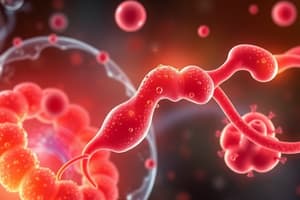Podcast
Questions and Answers
What is diabetes?
What is diabetes?
A chronic medical condition characterized by high blood sugar levels.
Which of the following is a type of diabetes?
Which of the following is a type of diabetes?
- Type 1 Diabetes
- Both A and B (correct)
- Type 2 Diabetes
- Type 3 Diabetes
What is the autoimmune reaction in Type 1 diabetes?
What is the autoimmune reaction in Type 1 diabetes?
An autoimmune reaction leads to insulin deficiency.
What is a common risk factor for Type 2 diabetes?
What is a common risk factor for Type 2 diabetes?
Match the following treatments with their diabetes type:
Match the following treatments with their diabetes type:
What is maltose?
What is maltose?
Maltase is an enzyme responsible for breaking down maltose into glucose.
Maltase is an enzyme responsible for breaking down maltose into glucose.
What happens when maltose is not digested due to enzyme deficiency?
What happens when maltose is not digested due to enzyme deficiency?
What is lactose intolerance?
What is lactose intolerance?
What symptom commonly occurs due to lactose intolerance?
What symptom commonly occurs due to lactose intolerance?
Flashcards
Diabetes
Diabetes
A chronic condition with high blood sugar due to either insufficient insulin production or poor insulin use.
Type 1 Diabetes
Type 1 Diabetes
An autoimmune disease where the body attacks its own insulin-producing cells.
Type 2 Diabetes
Type 2 Diabetes
A condition where the body's cells don't respond properly to insulin (Insulin Resistance).
Insulin Resistance
Insulin Resistance
Signup and view all the flashcards
Maltose Malabsorption
Maltose Malabsorption
Signup and view all the flashcards
Maltase
Maltase
Signup and view all the flashcards
Lactose Intolerance
Lactose Intolerance
Signup and view all the flashcards
Insulin Therapy
Insulin Therapy
Signup and view all the flashcards
Dietary Management (Diabetes)
Dietary Management (Diabetes)
Signup and view all the flashcards
Lifestyle Changes (Diabetes)
Lifestyle Changes (Diabetes)
Signup and view all the flashcards
Study Notes
Diabetes
- Diabetes is a chronic condition characterized by high blood sugar levels
- It's caused by the body not producing enough insulin or not using insulin effectively
- Two main types:
- Type 1: An autoimmune condition where the body attacks insulin-producing cells in the pancreas. Usually diagnosed in children and young adults.
- Type 2: More common, often associated with lifestyle factors. The body becomes resistant to insulin or doesn't produce enough. Usually develops in adults, increasingly in children.
Type 1 Diabetes Mechanism
- Autoimmune Reaction: The immune system mistakenly attacks and destroys insulin-producing beta cells in the pancreas.
- Insulin Deficiency: Insulin production significantly decreases, leading to high blood sugar levels because insulin isn't available to regulate blood glucose.
Type 2 Diabetes Mechanism
- Insulin Resistance: The body's cells become less responsive to insulin, making it hard for glucose to enter cells.
- Impaired Insulin Secretion: Over time, the pancreas may not produce enough insulin to overcome the resistance.
- Increased Gluconeogenesis: The liver may produce more glucose than necessary.
Diabetes Treatment (Type 1)
- Insulin Therapy: Regular insulin injections or an insulin pump to manage blood sugar levels.
- Monitoring Blood Sugar: Frequent testing to maintain target glucose levels.
- Dietary Management: A balanced diet with a focus on carbohydrate counting.
- Physical Activity: Regular exercise to improve insulin sensitivity and overall health.
Diabetes Treatment (Type 2)
- Lifestyle Changes: Diet, focusing on whole foods, high fiber, and low sugar. Regular physical activity to help control weight and improve insulin sensitivity.
- Oral Medications: Various medications (e.g., metformin) to lower blood sugar levels or improve insulin sensitivity.
- Insulin Therapy: May be required if blood sugar levels cannot be controlled with oral medications.
- Monitoring Blood Sugar: Regular blood sugar testing to guide treatment decisions.
Maltose Malabsorption
- Maltose malabsorption is a condition where the body does not properly digest maltose due to a shortage of the enzyme maltase.
- This leads to digestive issues.
- Undigested maltose travels to the large intestine where bacteria ferment it, producing gases such as hydrogen, carbon dioxide, and methane.
Maltose Malabsorption Symptoms
- Abdominal pain, bloating, gas, diarrhea, nausea, and vomiting.
Maltose Malabsorption Diagnosis and Management
- Diagnosis is done through a Hydrogen Breath Test or stool acidity test.
- Management involves limiting maltose-containing foods and enzyme supplements in some cases.
Lactose Intolerance
- Lactose intolerance is when the body struggles to digest lactose (a sugar in milk).
- This is often due to a shortage of lactase, an enzyme in the small intestine required for lactose digestion.
- Symptoms of lactose intolerance include diarrhea, gas, and bloating after consuming dairy products.
Lactose Intolerance Types
- Primary lactose intolerance: Inherited lack of lactase produced throughout life.
- Secondary lactose intolerance: Reduced lactase production caused by illness or injury.
- Developmental/Congenital lactose intolerance: Inability to make any lactase.
Congenital Insensitivity to Pain with Anhidrosis (CIPA)
- A rare genetic disorder where individuals lack pain sensation and sweat production.
- Symptoms include self-injury and overheating.
Studying That Suits You
Use AI to generate personalized quizzes and flashcards to suit your learning preferences.





